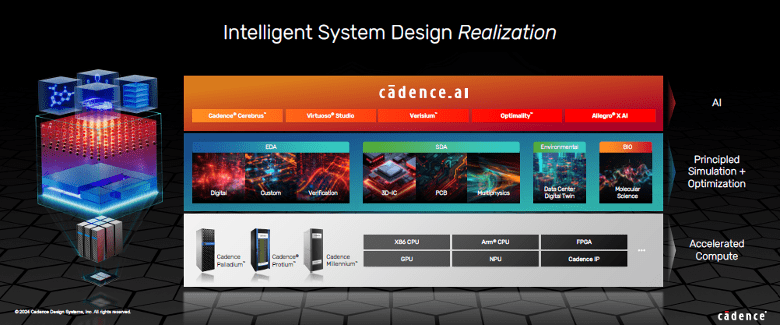The great things about CEO keynotes, at least from larger companies, is that you not only learn about recent advances but you also get a sense of the underlying algorithm for growth. Particularly reinforced when followed by discussions with high profile partner CEOs on their directions and areas of common interest. I saw this recently in Pat Gelsinger’s Intel Vision pitch and I saw it recently in Cadence’s Anirudh Devgan’s keynote and follow on discussions with Jensen Huang of NVIDIA and Cristiano Amon of Qualcomm which I will cover in a separate blog.

The big takeaways
Lots of good information on anticipated growth in key markets, especially an expectation that the semiconductor market will grow to a trillion dollars in the next few years. Anirudh thinks this may be an underestimate given fast growth in AI, datacenter, and automotive. The latter answers my earlier question about why everyone was asking for blogs on automotive. AI of course is driving a lot of growth but so are digital twins. We’re used to digital twin design in semiconductors (in the form of EDA/System Design & Analysis (SDA), but the concept has also been catching on in other markets like aerospace and automotive. Not just for electronics subsystems, now also in physical modeling which has traditionally relied more (as much as 80% of the design cycle) on much slower and more expensive prototype-based experimentation. Drug design is even further behind, offering (so far) limited advantages through virtualization. Yet aircraft, car and therapeutics designers want the same digital twin accelerators already enjoyed in electronics design.
Why the huge difference? There are obvious differences in disciplines: in fluid dynamics around wings or through jet engines, in mechanical CAD and multiphysics, in molecular dynamics. Yet these are well understood domains with decades of principled science and engineering/experimental practices to back them up. Virtual models for these systems have been possible but were commonly too slow and inaccurate to be useful.
In contrast, electronic design has aimed for a long time to be completely virtual. Anirudh attributes this success to a 3-layer cake: in the middle principled simulation and optimization to guarantee obligatory accuracy, sitting on top of accelerated compute to deliver many orders of magnitude improvement in throughput over even massive CPU parallelism, with AI on top to intelligently guide these analytics through massive design state spaces. In line with the Cadence computational software mantra, he sees potential to extend the same benefits to those other domains, as they are already seeing in modeling turbulent flows in CFD for aero and auto design.
Application to EDA/SDA
This philosophy also drives advances in EDA/SDA. Cadence Cerebrus is now demonstrating customer implementation results not only faster than manual trials but with better PPA. MediaTek is one cited example. Customers are seeing almost half the benefit of a node migration with better AI tools and optimization, a huge benefit. Analog design automation, long a holy grail, is also starting to make real progress. In verification, Cadence announced their Palladium Z3 and Protium X3 acceleration platforms, offering higher performance and lower power per gate for up to 48 billion gates. NVIDIA has been a big user of Palladium acceleration and a Palladium development partner for 20 years. Meanwhile hardware verification is complemented by the AI-driven Verisium platform to optimize across verification runs. In PCB and 3D-IC design Allegro remains the leading platform, especially in aerospace and defense and is now able to offer 10X productivity improvement through AI enhancement.
There is more in multiphysics optimization: Celsius for thermal simulation, Clarity for electromagnetics, Sigrity for signal integrity are now integrated in one platform for improved accuracy through tighter coupling. Together with Optimality for workflow optimization, the multiphysics platform claims significant productivity improvements from 3D-IC all the way up to rack level analytics and optimization. Finally, and also notable is that Cadence is increasing its investment in IP with a new leader and acquisitions of interface IP and cores particularly around 3D-IC/chiplet requirements.
Beyond EDA/SDA
Cadence is already aiming at playing a bigger role in total system design. Not just big electronics but expanding its role in automotive, aircraft, datacenter, power generation and transmission, football stadiums, and of course drug design. Not in one big step naturally but headed in those directions. Cadence are already partnered with McLaren and Honda for aerodynamic design, with the 49ers for sustainability optimization, with datacenters for power and cooling optimization, with Pfizer for advanced molecular design, and even in the International Maritime Organization’s efforts to make the shipping industry greener. Big goals but also huge opportunities 😀
I’ll have more to say on the molecular sciences topic in a separate blog. For now, I’ll just offer a brief prelude. This domain may seem far removed from the world of semiconductor design with some significant differences but in the initial stages of exploration – exploring options in a huge state space – research technologies have a lot in common. Which is good because drug design desperately needs help. In contrast to semiconductor design, the cost of developing a new drug is doubling every 9 years, which some have labeled Eroom’s Law (Moore’s law backwards😀). A 3-layer cake approach could help manage this cost with huge implications for health care. Which make Cadence’s acquisition of Open Eye look like a pretty smart move.
As I said, big advances and big goals. It’s encouraging to see a nominally EDA/SDA company expanding beyond those bounds.
Share this post via:





Comments
There are no comments yet.
You must register or log in to view/post comments.